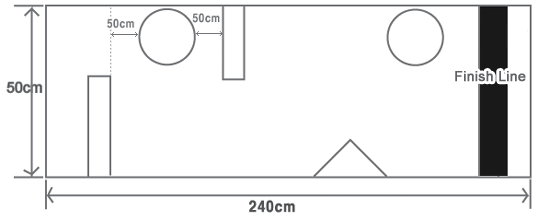|
1) Введение
Ходящий робот - хороший
учебный робот для
начинающих, позволяющий
понять особенности ходьбы
человека. Для того, чтобы
понять, как человек ходит.
учащиеся могут использовать
роботов, только таких,
которые перемещаются с
помощью ходьбы ногами, а не с
помощью колес.; Процессор
обрабатывает сигналы
датчиков и команды робота
для того, чтобы обходить
препятствия. Это может дать
учащимся основные
представления о работе
человеческого мозга.
2) Участники
Учащиеся в возрасте 13~18
лет
3) Состав команды
2~3 человека и1 робот на
команду
4) Условия
соревнований
Трасса будет
подготовлена Олимпийским
комитетом . Все роботы
стартуют со старта и тот
робот, который успешно
преодолеет все препятствия
и быстрее всех достигнет
финиша, будет победителем.
5) Правила игры
* Робот должен быть собран за
3 часа.
* Робот может иметь по
крайней мере 2 ноги во время
движения, никаких других
движителей, кроме ног, быть
не должно, максимальное
колличество ног не
ограничено
* Напряжение питания должно
быть меньше 11 В (1.5ВX 6 шт. как
правило)
*Робот может видоизменяться
и перестраиваться
автоматически или игроками,
огневые устройства
недопустимы.
Непосредственное
управление роботом со
стороны участников не
допускается. Участники
могут контактировать с
роботом только на стартах.
* Участники должны
использовать заранее
настроенный блок управления;
и , напротив, все
остальные части робота,
кроме блока управления,
должны быть собраны вместе в
на поле.
*Не допустимо применять
инфракрасное или
радиоуправление.
*Роботы должны
простоять на финишной линии
не менее 5 секунд.
*Конфигурация трассы будет
объявлена в день проведения
состязаний.
*Можно использовать
компьютер для
программирования, участники
должны его подготовить.
* Робот должен работать на
независимом источнике
электроэнергии. Тепловые
механизмы (двигатели) не
допускаются.
6) Трасса
* Размеры трассы 50см x 240
см (ширины и длины,
соответственно)
* Можно использовать только
препятствия, установленные
организаторами

7) Способ подсчета очков
* Результаты гонок
определяются по рейтингу. Рейтинг
определяется усреднением
двух времен прохождения
трассы
*Время прохождения трассы
фиксируется датчиками. В
случае непредвиденных
обстоятельств (отключения
питания, сбой датчиков ),
засчитываются
предварительные результаты
в качестве времени
прохождения трассы.
*В случае, если раунд не
завершен, время суммируется,
путем прибавления When one round
from two round is not completed, the record is
summed up with the lowest lank record plus 1 second.
*В случае получения
одинакового рейтинга,
выигрывает более быстрый во
второй игре
* Любая команда, участник
которой без разрешения
судьи или штаба состязаний,
коснулся робота, будет
дисквалифицирована.
|